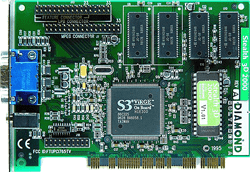
Have you ever wondered how much graphics cards have change over the past few years? How much clockspeed has jumped? If they’re getting any smaller? Check out the differences from 1995 to 2009 of that things putting pretty 3D graphics all over your monitor.
15 years makes a difference
Take a look at what a difference 15 years can make. Did you use any of the mentioned card for CAD in the early days? Do you still have old cards piled in the back room by the dog crate? I look at this and imagine what it will be in another 15 years.

Date Released: 1995
Interface: PCI
Shader Model: N/A
DirectX: 6
Manufacturing Process: 0.35 micron
Core Clockspeed: 66MHz
Memory Bus: 64-bit

Date Released: 2009
Interface: PCI-E
Shader Model: 4.0
DirectX: 10
Manufacturing Process: 55nm
Core Clockspeed: 648MHz
Memory Clockspeed: 2484MHz
Memory Bus: 512-bit
Transistors: 1400 million
Check out the Fun Facts as you go through the article. Here are some of my favorites:
“Following disappointing sales, ATI added the word ‘Turbo’ to the card’s moniker and released new drivers that were supposed to increase performance. In reality, the drivers only helped when benchmarking.”
“Nvidia hailed the GeForce 256 as “the world’s first GPU,” a claim made possible by being the first to integrate a geometry transform engine, a dynamic lighting engine, a 4-pixel rendering pipeline, and DirectX 7 features onto the graphics chip.”
“The FX5800’s two-slot cooling solution drew heavy criticism over its excessive noise. It was so loud, many likened it to a dustbuster, and it didn’t help that it looked a little bit like one.”
Read the entire article at MaximumPC
What about GPU’s for CAD?
If you’re interested on the transition that happened to make GPU’s more suitable for CAD apps, check out this paper on GPU for CAD (PDF link! – Right-click to download and save).
Image via Flickr



